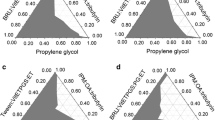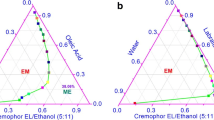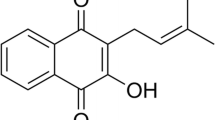Abstract
Silymarin is a standardized extract from Silybum marianum seeds, known for its many skin benefits such as antioxidant, anti-inflammatory, and immunomodulatory properties. In this study, the potential of several microemulsion formulations for dermal delivery of silymarin was evaluated. The pseudo-ternary phase diagrams were constructed for the various microemulsion formulations which were prepared using glyceryl monooleate, oleic acid, ethyl oleate, or isopropyl myristate as the oily phase; a mixture of Tween 20®, Labrasol®, or Span 20® with HCO-40® (1:1 ratio) as surfactants; and Transcutol® as a cosurfactant. Oil-in-water microemulsions were selected to incorporate 2% w/w silymarin. After six heating–cooling cycles, physical appearances of all microemulsions were unchanged and no drug precipitation occurred. Chemical stability studies showed that microemulsion containing Labrasol® and isopropyl myristate stored at 40°C for 6 months showed the highest silybin remaining among others. The silybin remainings depended on the type of surfactant and were sequenced in the order of: Labrasol® > Tween 20® > Span 20®. In vitro release studies showed prolonged release for microemulsions when compared to silymarin solution. All release profiles showed the best fits with Higuchi kinetics. Non-occlusive in vitro skin permeation studies showed absence of transdermal delivery of silybin. The percentages of silybin in skin extracts were not significantly different among the different formulations (p > 0.05). Nevertheless, some silybin was detected in the receiver fluid when performing occlusive experiments. Microemulsions containing Labrasol® also were found to enhance silymarin solubility. Other drug delivery systems with occlusive effect could be further developed for dermal delivery of silymarin.








Similar content being viewed by others
References
Afaq F, Adhami VM, Ahmad N, Mukhtar H. Botanical antioxidants for chemoprevention of photocarcinogenesis. Front Biosci. 2002;7:784–92.
Křena Vb, Walterováb D. Silybin and silymarin-new effects and applications. Biomed Papers. 2005;149(1):29–41.
Svobodová A, Psotová J, Walterová D. Natural phenolics in the prevention of UV-induced skin damage. A review. Biomed Papers. 2003;147(2):137–45.
Katiyar SK. Treatment of silymarin, a plant flavonoid, prevents ultraviolet light-induced immune suppression and oxidative stress in mouse skin. Int J Oncol. 2002;21(6):1213–22.
Katiyar SK. Silymarin and skin cancer prevention: anti-inflammatory, antioxidant and immunomodulatory effects (review). Int J Oncol. 2005;26(1):169–76.
Saller R, Melzer J, Reichling J, Brignoli R, Meier R. An updated systematic review of the pharmacology of silymarin. Forsch Komplementarmed. 2007;14:70–80. doi:10.1159/000100581.
Date AA, Naik B, Nagarsenker MS. Novel drug delivery systems: potential in improving topical delivery of antiacne agents. Skin Pharmacol Physiol. 2006;19(1):2–16. doi:10.1159/000089138.
Kreilgaard M. Influence of microemulsions on cutaneous drug delivery. Adv Drug Deliv Rev. 2002;54:S77–98. doi:10.1016/s0169-409x(02)00116-3.
Barry BW. Mode of action of penetration enhancers in human skin. J Control Release. 1987;6(1):85–97. doi:10.1016/0168-3659(87)90066-6.
ICH: validation of analytical procedures: text and methodology Q2(R1). http://www.ich.org/ (1994). Accessed 1 Aug 2009.
Dietary Supplements/Milk Thistle. The United States Pharmacopeia 30 and the National Formulary 25, vol 1. Rockville, MD: The United States Pharmacopeia Convention; 2007. p. 966–7.
Guy RH, Hadgraft J, Kellaway IW, Taylor M. Calculations of drug release rates from particles. Int J Pharm. 1982;11(3):199–207. doi:10.1016/0378-5173(82)90038-2.
Ho H-O, Hsiao C-C, Sheu M-T. Preparation of microemulsions using polyglycerol fatty acid esters as surfactant for the delivery of protein drugs. J Pharm Sci. 1996;85(2):138–43. doi:10.1021/js950352h.
Mo C, Zhong M, Zhong Q. Investigation of structure and structural transition in microemulsion systems of sodium dodecyl sulfonate + n-heptane + n-butanol + water by cyclic voltammetric and electrical conductivity measurements. J Electroanal Chem. 2000;493(1–2):100–7. doi:10.1016/s0022-0728(00)00350-8.
Lee J, Lee Y, Kim J, Yoon M, Choi Y. Formulation of microemulsion systems for transdermal delivery of aceclofenac. Arch Pharm Res. 2005;28(9):1097–102. doi:10.1007/bf02977408.
Moulik SP, Paul BK. Structure, dynamics and transport properties of microemulsions. Adv Colloid Interface Sci. 1998;78(2):99–195. doi:10.1016/s0001-8686(98)00063-3.
Djordjevic L, Primorac M, Stupar M, Krajisnik D. Characterization of caprylocaproyl macrogolglycerides based microemulsion drug delivery vehicles for an amphiphilic drug. Int J Pharm. 2004;271(1–2):11–9. doi:10.1016/j.ijpharm.2003.10.037.
Yuan Y, Li S-m, Mo F-k, Zhong D-f. Investigation of microemulsion system for transdermal delivery of meloxicam. Int J Pharm. 2006;321(1–2):117–23. doi:10.1016/j.ijpharm.2006.06.021.
Junyaprasert VB, Boonme P, Songkro S, Krauel K, Rades T. Transdermal delivery of hydrophobic and hydrophilic local anesthetics from O/W and W/O Brij 97-based microemulsions. J Pharm Pharm Sci. 2007;10(3):288–98.
Bonne C, Sincholle D. Cosmetic preparations useful for opposing skin aging containing an extract of the fruits of Silybum marianum. US patent US 4,749,573, 7 Jun 1988.
Han MH, Yoon WK, Lee H, Han S-B, Lee K, Park S-K, et al. Topical application of silymarin reduces chemical-induced irritant contact dermatitis in BALB/c mice. Int Immunopharmacol. 2007;7(13):1651–8. doi:10.1016/j.intimp.2007.08.019.
Liu L, Pang X, Zhang W, Wang S. Formulation design and in vitro evaluation of silymarin-loaded self-microemulsifying drug delivery systems. Asian J Pharm Sci. 2007;2(4):150–60.
Woo J, Kim T-S, Park J-H, Chi S-C. Formulation and biopharmaceutical evaluation of silymarin using SMEDDS. Arch Pharm Res. 2007;30(1):82–9. doi:10.1007/bf02977782.
Špiclin P, Homar M, Zupančič-Valant A, Gašperlin M. Sodium ascorbyl phosphate in topical microemulsions. Int J Pharm. 2003;256(1–2):65–73. doi:10.1016/s0378-5173(03)00063-2.
Vicentini FTMC, Simi TRM, Del Ciampo JO, Wolga NO, Pitol DL, Iyomasa MM, et al. Quercetin in w/o microemulsion: In vitro and in vivo skin penetration and efficacy against UVB-induced skin damages evaluated in vivo. Eur J Pharm Biopharm. 2008;69(3):948–57. doi:10.1016/j.ejpb.2008.01.012.
Svobodová A, Zdařilová A, Walterová D, Vostálová J. Flavonolignans from Silybum marianum moderate UVA-induced oxidative damage to HaCaT keratinocytes. J Dermatol Sci. 2007;48(3):213–24. doi:10.1016/j.jdermsci.2007.06.008.
Choo S-J, Ryoo I-J, Kim Y-H, Xu G-H, Kim W-G, Kim K-H, et al. Silymarin inhibits melanin synthesis in melanocyte cells. J Pharm Pharmacol. 2009;61(5):663–7. doi:10.1211/jpp.61.05.0016.
Acknowledgments
The authors would like to thank Chulalongkorn University Graduate Research Fund for partially financing this study. We also acknowledge Associate Professor Dr. Iman Saad Ahmed, College of Pharmacy, University of Sharjah, United Arab Emirates for her scientific review; Berlin Pharmaceutical Co., Ltd. (Thailand) for supplying silymarin; Croda Co., Ltd. (Thailand) for supplying glyceryl monooleate and ethyl oleate; and Kru Somboon farm (Ratchaburi, Thailand) for supplying the dead newborn pigs.
Author information
Authors and Affiliations
Corresponding author
Rights and permissions
About this article
Cite this article
Panapisal, V., Charoensri, S. & Tantituvanont, A. Formulation of Microemulsion Systems for Dermal Delivery of Silymarin. AAPS PharmSciTech 13, 389–399 (2012). https://doi.org/10.1208/s12249-012-9762-y
Received:
Accepted:
Published:
Issue Date:
DOI: https://doi.org/10.1208/s12249-012-9762-y




